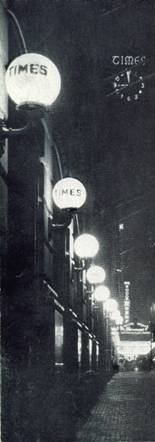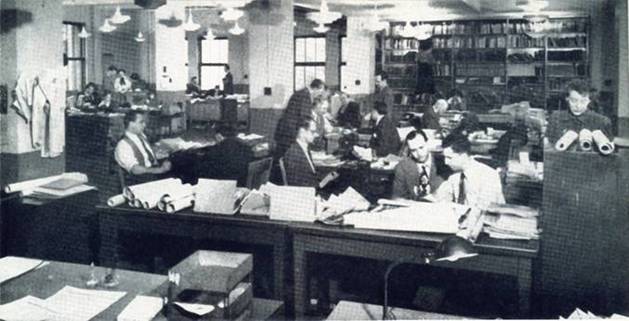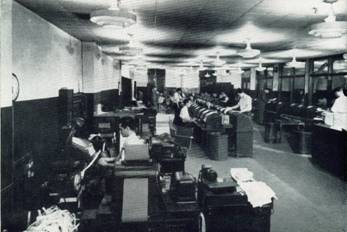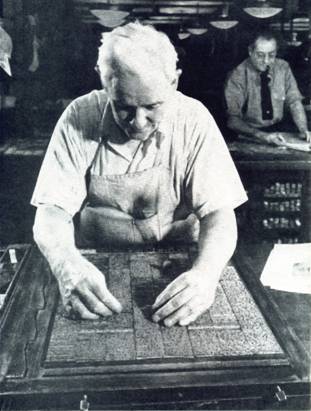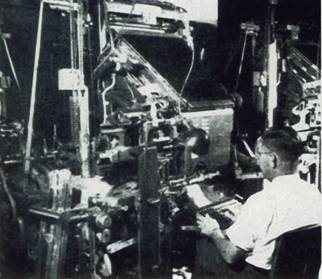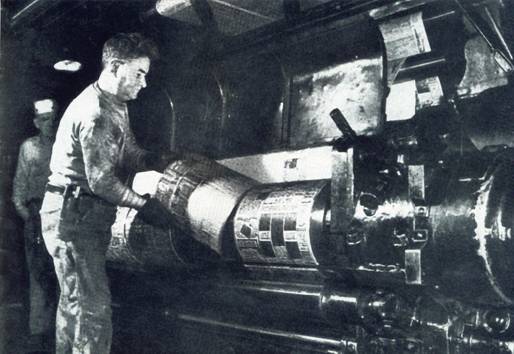|
The Old Grey Lady: The Way It Was By Robert D. McFadden |
|||||
|
New York Times The
grand entrance to the venerable old lady. |
New York Times Street of memory |
||||
|
By Robert D. McFadden
Look at the twirling,
surreal clock hands if you like. There’s really no need. You can tell the
deadline looms by the savage shouts of the men, by the crescendo of
thundering typewriters and jangling phones, by the fever rising in this
cavernous newsroom of iron gray and bare steel in Midtown Manhattan. Through the haze of
cigarette smoke, you can see reporters cradling receivers and pounding Smith-Coronas
and Royals; shirt-sleeved copy editors, a few in green eyeshades, hunched at
horseshoe desks; important men conferring under the windows and college boys
hurrying up the aisles to roars of “Copy!” You can feel the
place vibrate, a plunging roller-coaster, and the great presses underground
have not yet begun to rumble. It is a Friday evening, May 19, 1961, my first
night as a copyboy at The New York Times. I have just turned 24, and while
I’ve been a reporter at three stepping-stone newspapers, I am terrified and
thrilled at being — at long last — in this exotic setting of disciplined
chaos. If the center of the
world is the third-floor newsroom of the venerable Gray Lady at 229 West 43rd
Street, its epicenter is an unimposing, waist-high desk called “the post,”
with a railing that separates the ranks of reporters from the bailiwicks of
editors. It’s a symbolic barrier, but as I will learn, most things at The
Times are symbolic as well as real: rarely do careers here cross the
reporter-editor divide, with the exception of the top editors, nearly all of
whom are former reporters. Sammy Solovitz, a
growling, chain-smoking, 4-foot, 9-inch tyrant who is the boss of the
copyboys, presides at the post. His fingers are stained yellow, and he has
the darting suspicious eyes of a jailer. “Co-py!” someone shouts
from the maelstrom. “That’s you kid,” Sammy
rasps through his cigarette. I am suddenly part of
the action, earning my $45 a week. I rush out for the copy Charles Grutzner
has just ripped out of his machine. He does not look up. He’s already banging
away on another take. What I retrieve is just
a fat paragraph, and it’s not written on a single piece of paper, but on a
10-part “book” — an original copy (my favorite oxymoron) and 9 flimsies
separated by carbons. In a deft snapping motion that is surprisingly hard to
learn, Sammy tears the book apart for distribution to the editors. The
original goes to the backfield and the copy desk. From the post, you can
survey much of the block-long newsroom. It is a shabby Valhalla, with
soot-streaked, 17-foot ceilings cluttered with beams, pneumatic tubes and a
bewildering maze of ducts, pipes and suspended lighting fixtures.. The walls
are battleship gray below, and dingy beige above, an uneven line. The décor
is functional: calendars, clocks, maps, bulletin boards, filing cabinets,
fire extinguishers. The concrete floors are
covered with grayish-yellowish tiles streaked with an effluvia of crushed
cigarettes, spilled coffee and tobacco spittle. There are no ashtrays, and
the edges of desks are mottled with burns. Brass spittoons are long gone, but
wastebaskets serve the curmudgeons. The whole place is adrift in paper:
tottering in stacks, skewered on spikes, littered over the floors, heaped on
desks. The newsroom, I quickly
discover, is an archly formal workplace. Everyone is addressed as Mister,
Miss or Mrs. The men wear suits and neckties, though they are mostly rumpled
and askew. There are no time-clocks to punch, but no one arrives late or
leaves without an editor’s “Good night.” Reporters are summoned over an
intimidating loudspeaker that booms: “Mr. Manley! Report to the City Desk!” Bylines, always rare in
The Times, are still reserved for senior writers or exceptional reporting
efforts. They too are stilted. It’s Robert, not Bob; Thomas, not Tom. And the
paternal Times, not its children, will decide what to call writers in print:
A.M. Rosenthal, not Abraham M. Rosenthal. Assignments and
instructions are given with no-nonsense severity: polite, but no questions
please. The newsroom wears a cloak of old-fashioned gentility, and as later
becomes clear, it masks a great deal — the bottle in a drawer, the poker game
at the back, the gift-wrapped cases of liquor at Christmastime. But it also
covers an undercurrent of ruthless competition and an uncompromising
intellectual honesty. The general news
department in 1961 is a nearly exclusive bastion of white men. Edith Evans
Asbury and Laurie Johnston are among the few women on the local staff outside
the realms of food, society and women’s news. But newspapermen still talk of
Anne O’Hare McCormick, the pioneering foreign affairs correspondent, who won
a Pulitzer in 1937 and died in 1954. There are only three
black men in the newsroom now: Layhmond Robinson Jr., a reporter covering
politics; Theodore Jones, a general assignment reporter, and Robert
Claybrooks, a news assistant on the city desk. Black men in white gloves take
you up and down in the elevators, the cafeteria has black and Hispanic workers
and nearly all the porters who clean the premises overnight are black. The newsroom is a
hidebound hierarchy, and where you sit (if you sit at all) signifies your
rank and is as important as any title. Star reporters are arrayed like saints
across the front: Homer Bigart, Peter Kihss, Foster Hailey and Murray
Schumach. They all reside on one side of a line of pillars; the rewrite bank
on the other side does not count, although it is vital and highly respected.
The unseen heroes are Times correspondents in Europe, Asia, Africa and Latin
America, in Washington and across the nation. Behind the city room
stars, an army of talented reporters, also seated in order of rank, stretches
away toward 44th Street. They work at steel desks whose central feature is a
disappearing typewriter bolted to the underside of the desktop; it can be
rolled up to work on, or down into a hidden well. It is monstrously heavy;
you could lose fingers if it slips. Chairs are the swivel type, although Mr.
Schumach prefers an uncomfortable straight-back chair because, he says, it is
less likely to be stolen. Further behind the city
reporters, back by the 44th Street windows, glass-topped partitions stake out
territories for specialized news departments: culture, financial-business,
sports, ships and aviation. There are cubicles for the critics — Brooks
Atkinson, Harold C. Schonberg, Bosley Crowther and others. And there is a
niche for a bevy of writers who compose the hourly radio news bulletins on
WQXR.
New York Times The old
Sunday Department responsible for the weekly Magazine, Book Review, Drama and
News of the Week in Review sections. On the 43rd Street side
of the post, the newsroom editors camp at islands of steel desks shoved
together for the city, national and foreign news operations, each with a
U-shaped copydesk as an appendage. Nearby are the picture and soc-obit desks.
Besides society news and obituaries, the latter handles theater reviews, news
of the arts and other odds and ends. Frank Adams, the city
editor, is pointed out to me. He is a portly, florid man responsible for 200
reporters and editors and a news report heavy on municipal affairs and
written with plodding fidelity to facts and figures, but with little flair
for the literature of journalism. I’m told that good staff writers, including
Gay Talese, chafe under the yoke. In a year, after my apprenticeship as
copyboy, news clerk and news assistant in various departments, Mr. Adams will
send me a note saying I’ve been promoted to the reporting staff. In a corner behind the
archipelago of editing desks is the inner sanctum of Turner Catledge, the
managing editor. Around his office is a little railing that fences off his
bullpen of assistants. It is the O.K. Corral of senior editors empowered to
dictate the content and placement of major news in The Times. These gunslingers
include Theodore M. Bernstein, Lewis Jordan and Robert Crandall — a cabal of
largely anonymous men who, given the gist of the top 20 stories from around
the world, will draw up a front page in two minutes, showing the historical
perspective, relative importance and relationships of the day’s news. They
make marvelous sense of it all for millions, including news editors across
America. Scanning further along
the 43rd Street side, there is the radio room, where crackling receivers
bring in the transmissions of the city police and fire dispatchers, and
reports from the Coast Guard, from ships at sea and other news sources,
including short-wave broadcasts from foreign capitals around the world. In the southeast corner
is the wire room, the nerve center of telegraphic operations. More than a
million words come through this room every day, and 185,000 of them are
printed in The Times. Here are Telex machines carrying messages to, and
dispatches from, 30 Times correspondents around the world, 23 Washington
reporters and scores of reporters and stringers across the country.
Here, too, are batteries
of teletype machines pounding out the bulletins and daily budgets of The
Associated Press, The United Press, The International News Service, Reuters, Agence
France-Presse, Tass and other global news services. The AP alone has a dozen
machines. Several more carry reports from Washington, and a cable is reserved
for London bureau traffic, which serves as a funnel for news reports from all
over Europe, the Middle East and Africa. At the horseshoe-shaped
copy desks, slot bosses in the center distribute copy to editors on the rim,
who bend over their labors with a lifetime of skepticism, making liberal use
of black pencils to slash away excess verbiage or rewrite flabby leads,
scissors and paste pots to rearrange paragraphs, and copies of Roget’s
Thesaurus to craft headlines that will fit in The Times’s narrow columns,
eight across a page. To many reporters, copy
editors are fussy grammarians, sticklers for spelling and butchers of copy.
To many editors, reporters are careless louts obsessed with adjectives. It is
only a cultural abyss, one of many on the paper. The truth is that reporters
and copy editors are more alike than they admit. All are well-read if not
well-educated, students of literature, history, political science, economics,
the law, arts and sciences. And they are guided by impartiality, fair play
and common sense. As I look around this
room, I ask myself: Do I have what it takes? My journalism degree from the
University of Wisconsin seems less important than my experience on The
Wisconsin Rapids Tribune, The (Madison) Wisconsin State Journal and The
Cincinnati Enquirer. I’ve been hired by Richard D. Burritt, an assistant
managing editor, at a time of transition in journalism, with an aging
generation of largely self-taught generalists, many of them two-finger
typists, giving way to college-educated men and women with specialized
talents and presumably broader visions. But most of us must begin humbly. I and the other
copyboys, constantly on the run, carry the edited copy from wire baskets on
each copydesk to a set of pneumatic tubes at the east end of the newsroom.
The tubes look like something out of an anatomy textbook: veins and arteries
soaring up, separating, disappearing into the lofty ceiling. I meet the clerk in
charge of the tubes, an Ivy Leaguer in a three-piece suit with a Phi Beta
Kappa key on a gold chain across his vest. He has degrees from Harvard and
Columbia, speaks three languages and is just now drawing a map of Africa,
freehand, with national boundaries and capitals. My ambitious heart sinks as
he rolls up the copy I’ve given him, puts it in a cylinder and sends it away
— whoosh! — in a burst of suctioned air to the fourth-floor composing room. After the deadline,
Sammy takes me up to see where the tubes come out. We ride in a tiny elevator
— a vertical coffin with room for two that often carries three or four,
groaning slowly between the white-collar third floor and the blue-collar
fourth floor, yet another in-house cultural divide. The door opens at the
composing room and we spill out into another world: a Martian landscape of
Mergenthaler Lineotypes where printers like pianists play bizarre keyboards
(“etaoin shrdlu”), casting words into hot type, set backwards a line at a
time until a tray is assembled for the inked galley proofs and the page
lockups. The non-words “etaoin shrdlu” are the first 12 keys in two rows at
the keyboard’s left; they’re used to fill out a garbled line of type,
indicating it should be discarded in a “hellbox.”
Nearby, ink-stained
proofreaders sweat under the lights, trying to catch errors. It is hard to
imagine how they concentrate in all this noise and activity — a din of
clattering typesetters, the swirls of rushing people, mallets banging on
steel frames. It is a muscular place, governed by strange customs and alien
terms, and I try not to stray far from the elevator. But just a few feet from
the door, I am able to watch the final work on the Page One lockup. All the
elements of the front page — the type for articles and headlines, the
photo-engraved picture cuts, the weather and edition information that flank
The New York Times logo at the top — are set into a steel frame, called a
chase, atop a waist-high table known as the stone. Dave Lidman, a makeup
editor with a kindly face, motions me over and takes some of the mystery out
of the operation. He checks the whole page, reading type that is upside down
and backward. If he spots an error, he does not touch the type. It’s against
the union rules for an editor to handle type, he explains, so he must ask a
printer to make fixes. When Dave is satisfied, the frame is tightened with
blocks of wood and screws. Mallet blows are struck to ensure that the type is
level and nothing is loose. Then, Dave explains, the
locked page is wheeled to a matrix operation, where a cardboard-like mat is
pressed down on the locked-up type with enormous force — 2,100 pounds per
square inch — under a cylindrical roller. The mat, a positive image of the
page, is dropped down a chute to the stereotype room five floors below. There, the mat is curved
into a half-barrel shape and molten lead is sprayed against it. The resulting
metal plate is an exact replica — in negative again — of the page set in type
in the composing room. The plate, when cooled in a bath of water, is fitted
onto a cylinder of the press. Paper rolling over the inked plates will pick
up the positive image.
New York Times A
pressman placing the stereotype plate on the press. When all is ready, the
pressmen stand back, a bell rings, a button is pushed and the gargantuan
presses, fed by great rolls of newsprint and tons of ink, begin to roll. The
noise is deafening. Indeed, many pressmen are congenitally deaf. Soon the
paper rolls are speeding at 1,200 feet a minute, and the presses are churning
out 400,000 newspapers an hour. It is a two-part paper, averaging 60 pages on
weekdays and a whopping 436 pages on Sundays. The first edition is in.
There are two more and a postscript to go before the night is over. Back in the newsroom, an
eerie quiet has settled in, as if a storm has passed. Darkness has walled in
the windows. The phones are silent. Many reporters have gone, but the rewrite
bank and the copydesks are still manned. The newsroom is a mess. Wastebaskets
overflow with crumpled paper and cardboard coffee cups. Brown stains snake
over desktops. Cigarette butts carpet the floor. Sammy sends me and
another copyboy down to the mail room for bundles of the City Edition now
rolling off the roaring presses in the subterranean dungeons. You can feel
the vibrations in the mail room, a droning, reverberating hall of conveyor
belts and frenetic activity. It is just off the lobby and conveniently next
to the bays where the trucks wait to be loaded for deliveries to homes,
newsstands, train stations and airports. The weekday circulation is nearly
700,000, and double that on Sundays. A grouchy mailer warns
us to stand back from the conveyor belts and scoops up armfuls of papers for
us. They are warm and smell of newsprint and fresh ink that immediately rubs
off onto our hands. We carry them up and distribute copies to all the
reporters and editors. A rewriteman sends me
scurrying for clips on a big-shot who has died. I trek west down a long hall
that comes out in the morgue, an enormous, brightly-lighted room packed with
filing cabinets that rise to the ceiling and run back to a vanishing point.
At the counter (“No Admittance!”), I fill out a request for the morgue
attendant, who disappears into the stacks. Soon, he returns with a file
folder jammed with tattered, yellowing clips on the dead big-shot. “Okay kid,” Sammy says
when I get back. “You can go out for the papers now.” He means the other
papers — The Herald Tribune, The Daily News, The Daily Mirror, The New York
Post, The Journal-American and The World-Telegram & The Sun. He gives me change to
pay for them, and down I go again, in the elevator, through the marble lobby,
past the guard and the cluster of press agents and other news addicts waiting
for papers hot off the presses. Out in the cool night air, I breathe in the
truck fumes and the illusory romance of the city. Down at the corner,
Times Square opens like a jeweled kaleidoscope: a blaze of moving neon
lights, the Camel billboard blowing smoke rings, marquees advertising sin,
the madrigal of traffic played by Father Knickerbocker, the crowds of
tourists and pickpockets, preachers and three-card monte sharks. Chubby
Checker is doing the newfangled twist at a club across the way. At the crossroads of Broadway
and Seventh Avenue rises the Times Tower, the paper’s home from 1903 to 1913.
It’s a slender, beautiful skyscraper, but puny compared to the “annex” that
became the Times’s historic 20th Century headquarters, a 14-story pile of
stone and steel with a mansard roof that somehow blends an architecture of
indestructibility with the graceful lines of a French chateau. News bulletins in
running lights trickle around the fourth-floor exterior of the Times Tower.
At its base is a newsstand plump with local and out-of-town papers. I buy
copies of the local competition and head back. A night editor quickly scans
them and clips stories we’ve somehow missed. There are always a few. The
cuttings are handed out to rewritemen, who will work the phones and chase them
down for the later editions. By 2 a.m., all the exclusives are broken. At 2:30, I and another
copyboy are assigned a final task by Sammy: to gather up and bundle every
scrap of reporters’ notes and wire copy in the newsroom. We pack it all in a
giant ball, tie it with string and haul it to a storage room for a month or
two of safekeeping. It often happens, I am told, that the old notes and wire
stories are needed to verify or correct published material. By 3 a.m., the skeleton
staff is given the “Good night!” As we step out into 43rd
Street under the white “Times” globes, Sammy, a rewriteman and a few editors
head across the street to Gough’s, the watering hole of Timesmen. I’m invited
along. Despite the late hour, Gough’s is still busy. We mingle with
compositors, pressmen and other lobster shift stragglers, many wearing square
hats crafted from sheets of tomorrow’s Times, some “talking” in sign
language. Over a couple of beers
at the bar, the day is rehashed, the old stories are retold. For my part, I’m
filled with awe at this day. It’s hard to grasp how the paper has come
together — a million words, the work of thousands, all churned into an
erudite rendering of yesterday’s world, and against the deadlines. I’m
exhausted, but feel good about what’s ahead. A world of possibility has
opened up. The Times — this institution, this idea, this place of steel and
stone — seems indestructible. But who knows? Note:
This article first appeared in Ahead of The Times, an in-house Intranet site
of The New York Times. |
|||||

